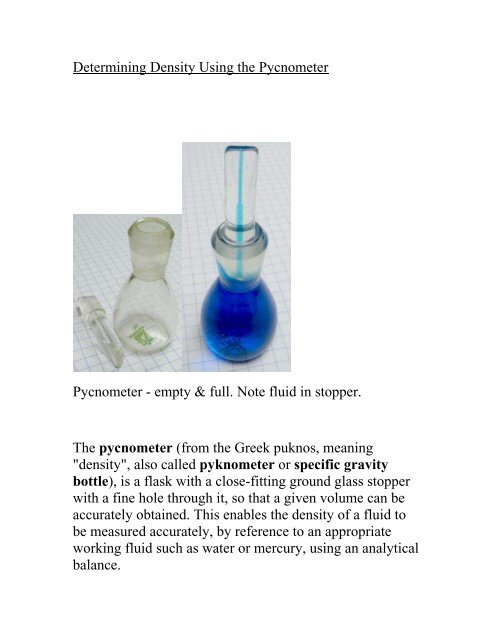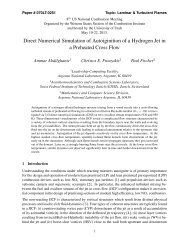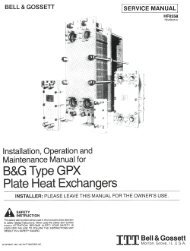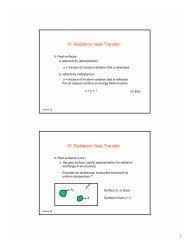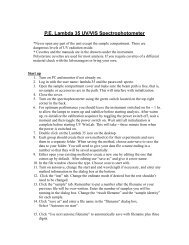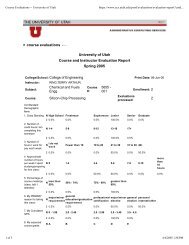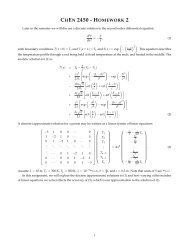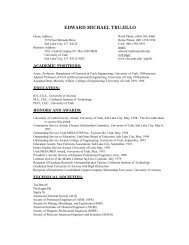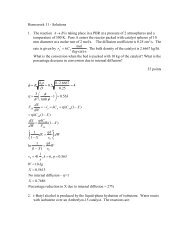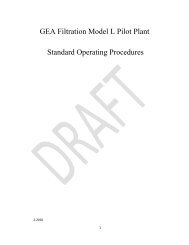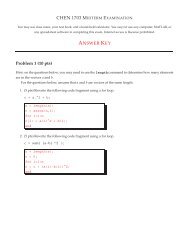Determining Density Using the Pycnometer Pycnometer - empty ...
Determining Density Using the Pycnometer Pycnometer - empty ...
Determining Density Using the Pycnometer Pycnometer - empty ...
You also want an ePaper? Increase the reach of your titles
YUMPU automatically turns print PDFs into web optimized ePapers that Google loves.
<strong>Determining</strong> <strong>Density</strong> <strong>Using</strong> <strong>the</strong> <strong>Pycnometer</strong><br />
<strong>Pycnometer</strong> - <strong>empty</strong> & full. Note fluid in stopper.<br />
The pycnometer (from <strong>the</strong> Greek puknos, meaning<br />
"density", also called pyknometer or specific gravity<br />
bottle), is a flask with a close-fitting ground glass stopper<br />
with a fine hole through it, so that a given volume can be<br />
accurately obtained. This enables <strong>the</strong> density of a fluid to<br />
be measured accurately, by reference to an appropriate<br />
working fluid such as water or mercury, using an analytical<br />
balance.
If <strong>the</strong> flask is weighed <strong>empty</strong>, full of water, and full of a<br />
liquid whose specific gravity is desired, <strong>the</strong> specific gravity<br />
of <strong>the</strong> liquid can easily be calculated. The particle density<br />
of a powder, to which <strong>the</strong> usual method of weighing cannot<br />
be applied, can also be determined with a pycnometer. The<br />
powder is added to <strong>the</strong> pycnometer, which is <strong>the</strong>n weighed,<br />
giving <strong>the</strong> weight of <strong>the</strong> powder sample. The pycnometer is<br />
<strong>the</strong>n filled with a liquid of known density, in which <strong>the</strong><br />
powder is completely insoluble. The weight of <strong>the</strong><br />
displaced liquid can <strong>the</strong>n be determined, and <strong>the</strong>nce <strong>the</strong><br />
specific gravity of <strong>the</strong> powder.
The pycnometer is used in ISO standard: ISO 1183-1:2004,<br />
and ASTM standard: ASTM D854.<br />
• The pycnometer is delicate and expensive; exercise<br />
care when handling it.<br />
• The bulb and stopper of <strong>the</strong> pycnometer are both<br />
engraved with <strong>the</strong> same number. Be sure that you do<br />
not inadvertently switch stoppers with someone else;<br />
check <strong>the</strong> numbers occasionally.<br />
• The pycnometer must be clean and DRY before <strong>the</strong><br />
initial weighing.<br />
• To fill <strong>the</strong> pycnometer with liquid, use a Pasteur pipet<br />
to fill <strong>the</strong> bulb to about halfway up <strong>the</strong> neck (<strong>the</strong>re is<br />
usually a white mark). Then slowly insert <strong>the</strong> capillary<br />
stopper.<br />
• When full, <strong>the</strong>re should be NO air bubbles in <strong>the</strong> bulb<br />
or capillary of <strong>the</strong> pycnometer, and no air space at <strong>the</strong><br />
top of <strong>the</strong> capillary.<br />
• Before weighing <strong>the</strong> full pycnometer, <strong>the</strong> outside<br />
should be perfectly dry.
Pycnometric method: Obtain a pycnometer and glass<br />
stopper from your lab instructor.<br />
Carefully clean <strong>the</strong> glassware with soap and water and <strong>the</strong>n<br />
rinse with a small amount of acetone<br />
as described above. Weigh <strong>the</strong> dry flask and stopper on <strong>the</strong><br />
analytical balance in <strong>the</strong> balance<br />
room. Determine <strong>the</strong> exact volume of your pycnometer by<br />
filling it fully with water, inserting<br />
<strong>the</strong> stopper, and tapping <strong>the</strong> sides gently to remove <strong>the</strong> air<br />
bubbles. Dry <strong>the</strong> sides and weigh <strong>the</strong><br />
full pycnometer on <strong>the</strong> analytical balance. Measure <strong>the</strong><br />
temperature of <strong>the</strong> water. Use <strong>the</strong> known<br />
density of water located in <strong>the</strong> CRC handbook to determine<br />
<strong>the</strong> volume of water contained in <strong>the</strong><br />
full pycnometer flask. Be certain to use <strong>the</strong> known density<br />
value at <strong>the</strong> correct temperature.


